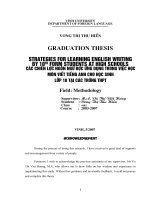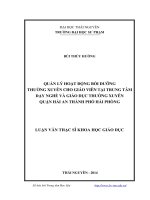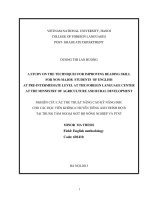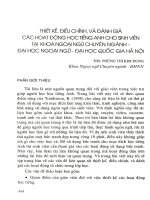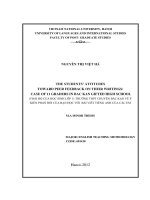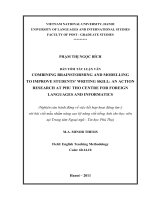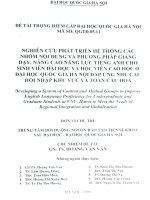Nghiên cứu hành động về việc kết hợp hoạt động tìm ý với bài viết mẫu nhằm nâng cao kỹ năng viết tiếng Anh cho học viên tại Trung tâm Ngoại ngữ-Tin học Phú Thọ
Bạn đang xem bản rút gọn của tài liệu. Xem và tải ngay bản đầy đủ của tài liệu tại đây (1.74 MB, 61 trang )
VIETNAM NATIONAL UNIVERSITY, HANOI
UNIVERSITY OF LANGUAGES AND INTERNATIONAL STUDIES
FACULTY OF POST - GRADUATE STUDIES
*********
PHẠM THỊ NGỌC BÍCH
BẢN TÓM TẮT LUẬN VĂN
COMBINING BRAINSTORMING AND MODELLING
TO IMPROVE STUDENTS’ WRITING SKILL: AN ACTION
RESEARCH AT PHU THO CENTRE FOR FOREIGN
LANGUAGES AND INFORMATICS
(Nghiên cứu hành động về việc kết hợp hoạt động tìm ý
với bài viết mẫu nhằm nâng cao kỹ năng viết tiếng Anh cho học viên
tại Trung tâm Ngoại ngữ - Tin học Phú Thọ)
M.A. MINOR THESIS
Field: English Teaching Methodology
Code: 60.14.10
Hanoi – 2011
VIETNAM NATIONAL UNIVERSITY, HANOI
UNIVERSITY OF LANGUAGES AND INTERNATIONAL STUDIES
FACULTY OF POST - GRADUATE STUDIES
*********
PHẠM THỊ NGỌC BÍCH
BẢN TÓM TẮT LUẬN VĂN
COMBINING BRAINSTORMING AND MODELLING
TO IMPROVE STUDENTS’ WRITING SKILL: AN ACTION
RESEARCH AT PHU THO CENTRE FOR FOREIGN
LANGUAGES AND INFORMATICS
(Nghiên cứu hành động về việc kết hợp hoạt động tìm ý
với bài viết mẫu nhằm nâng cao kỹ năng viết tiếng Anh cho học viên
tại Trung tâm Ngoại ngữ - Tin học Phú Thọ)
M.A. MINOR THESIS
Field: English Teaching Methodology
Code: 60.14.10
Supervisor: Dr. NGUYỄN HUY KỶ
Hanoi – 2011
iv
TABLE OF CONTENTS
Declaration………………………………………………………………………………………i
Acknowledgements…………………………………………………………………………… ii
Abstract……………………………………………………………………………… iii
Table of contents……………………………………………………………………………….iv
List of abbreviations………………………………………………………………… vii
List of figures, tables and charts…………………………………………………… viii
PART A: INTRODUCTION…………………………………………………………………1
1. Rationale…………………………………………………………………………………… 1
2. Objectives of the study……………………………………………………………………….2
3. Research questions………………………………………………………………… 2
4. Scope of the study………………………………………………………………………… 2
5. Method of the study………………………………………………………………………….2
6. Significance of the study…………………………………………………………………… 2
7. Design of the study………………………………………………………………… 3
PART B: DEVELOPMENT………………………………………………………………….4
CHAPTER 1: LITERATURE REVIEW……………………………………………………….4
1.1. Definitions of writing…………………………………………………………… 4
1.2. The role of writing in language teaching and learning…………………………………….4
1.3. Approaches to teaching writing……………………………………………………… 5
1.3.1. Product approach……………………………………………………………………6
1.3.2. Process approach…………………………………………………………………….7
1.4. The pre-writing stage ………………………………………………………………….10
1.4.1. Definition………………………………………………………………………… 10
1.4.2. Types of pre-writing techniques………………………………………………… 10
1.4.2.1. Brainstorming…………………………………………………………… 11
1.4.2.1.1. Definition……………………………………………………….11
1.4.2.1.2. Rules of brainstorming……………………………………… 12
v
1.4.2.2. Modelling………………………………………………………………….12
1.4.2.2.1. Definition…………………………………………………… 12
1.4.2.2.2. Rules of modelling…………………………………… 13
1.4.2.2.3. Some arguments against modelling………………………… 13
1.5. Related studies and fitness of the present study into the field……………………………14
CHAPTER 2: METHODOLOGY…………………………………………………………….16
2.1. Rationale for the use of an action research……………………………………………….16
2.2. The context of the study………………………………………………………… 18
2.2.1. An introduction of Phu Tho Centre for Foreign Languages and Informatics………18
2.2.2. The English Language Teacher Group…………………………………………… 18
2.2.3. The writing program for the English supplementary training course at PTCFI……19
2.2.4 Participants…………………………………………………………………………19
2.3. Action research procedures……………………………………………………………….19
2.4. Data collection……………………………………………………………………………22
2.4.1. Instruments for data collection…………………………………………… 22
2.4.1.1. Pre-test and post-test……………………………………………………… 22
2.4.1.2. Pre- and post- questionnaires……………………………………………….23
2.4.1.3. A collection of students’ writing……………………………………………23
2.4.2. Data collection procedures………………………………………………………….23
CHAPTER 3: RESULTS AND DISCUSSIONS…………………………………… 25
3.1. Data collected before the action plan implementation………………………………… 25
3.1.1. The results of pre-test……………………………………………………………….25
3.1.2. The results of pre- questionnaire………………………………………………… 26
3.2. Data collected from analysis of students’ writing during the action
plan implementation…………………………………………………………………… 30
3.3. Data collected after the action plan implementation…………………………… 31
3.3.1. The results of post-test…………………………………………………….…… 31
3.3.2. The results of post-questionnaire………………………………………………….32
3.4. Action research evaluation……………………………………………………………… 35
vi
3.5. Some major findings and discussions………………………………………………… 36
PART C: CONCLUSION………………………………………………………………… 39
1. Recapitulation …………………………………………………………………………… 39
2. Implications for classroom practice……………………………………………………… 40
3. Limitations of the study…………………………………………………………………….40
4. Suggestions for further studies…………………………………………………………… 41
REFERENCES……………………………………………………………………………… 42
APPENDICES…………………………………………………………………………………I
vii
LIST OF ABBREVIATIONS
PTCFI: Phu Tho Centre for Foreign Languages and Informatics
EFL: English as a Foreign Language
ESL: English as a Second Language
Ss: Students
viii
LIST OF FIGURES, TABLES AND CHARTS
Figure 1: Action research cycle
Table 1: Students’ writing performance in pre-test
Table 2: Students’ attitudes towards writing and their interests in writing lessons
Table 3: Students’ writing habits
Table 4: Students’ difficulties in writing lessons
Table 5: Students’ writing performance from Unit 8 to Unit 12
Table 6: Students’ writing performance in post-test
Table 7: Students’ attitudes towards writing and their interests in writing lessons
Table 8: Students’ writing habits
Table 9: Students’ opinions about the combination of brainstorming and modelling activities
Chart 1: Students’ writing performance at average to excellent level from pre-test to post-test
via the action plan implementation (Pre-test, Unit 8, Unit 9, Unit 10, Unit 11, Unit 12 and
post-test)
1
PART A: INTRODUCTION
1. Rationale
Nowadays, the goal of teaching and learning foreign languages in general and English
in particular is providing learners with the communicative competence. To acquire the
communicative competence, four language skills: reading, speaking, listening and writing need
to be officially taught at any universities, colleges and schools, among which writing skill is
very important because it is one of the two productive skills. It is also because of the fact that
besides speaking, people frequently have to communicate with each other in writing. Moreover,
writing serves as an aid to learning. “First, writing reinforces the grammatical structures, idioms,
and vocabulary that we have been teaching our students. Second, when our students write, they
also have a chance to be adventurous with the language, to go beyond what they have just
learned to say, to take risks. Third, when they write, they necessarily become very involved
with the new language; the effort to express ideas and the constant use of eyes, hand, and brain
is a unique way to reinforce learning. As writers struggle with what to put down next or how to
put it down on paper, they often discover something new to write or a new way of expressing
their idea. They discover a real need for finding the right word and the right sentence. The close
relationship between writing and thinking makes writing a valuable part of any language
course” (Raimes, 1983: 3).
Actually, because of the above mentioned reasons, writing is important for any language
course with no exception for language courses at Phu Tho Centre for Foreign Languages and
Informatics. However, writing skill poses great problems for the students at the centre.
Particularly, students recognize “the characterization of writing periods as times of sighing,
pencil-chewing, foot-shuffling agony” (Hedge, 1988: 5). They find it difficult to generate ideas
and organize ideas in a logical sequence but “ideas should arguably be seen as the most
important aspect of writing” (Ur, 1996: 163). This fact has inspired the researcher to find out
the way to help them overcome difficulties in generating and organizing ideas when writing in
English. In this regard, brainstorming and modelling are possibly effective activities which
provide learners with ideas in writing. Thus, the author has conducted a research on combining
brainstorming and modelling with a view to helping the students improve their writing skill
2
2. Objectives of the study
This study is designed to improve the students’ writing skill by combining brainstorming
and modelling. Thus, it has two objectives:
- Exploring the possible reasons for students’ weak writing competence
- Justifying the effects of the combination of brainstorming and modelling on students’
writing skill
3. Research questions
In order to achieve the objectives mentioned above, the study seeks to answer three
following questions:
1. What are the reasons that lead to students’ weak writing competence?
2. How does the combination of brainstorming and modelling affect students’ writing
skill at PTCFI?
3. What are the students’ opinions about the combination of brainstorming and modelling?
4. Scope of the study
The research was carried out in an English supplementary training class with 30
students at Phu Tho Centre for Foreign Languages and Informatics. Regarding its scope, the
research focused on justifying the effects of the combination of brainstorming and modelling at
the pre-writing stage on the students’ writing performance in terms of content, organization,
vocabulary, language use and mechanics.
5. Method of the study
The method employed in this study is an action research, with the use of a number of
instruments, namely pre-questionnaire, post-questionnaire, pre-test, post-test and a collection of
students’ writing. Action research has proved to be the best choice for this study because the
study has the aim of improving the students’ writing skill within a certain context.
6. Significance of the study
Being one of the two productive skills, writing plays an important role in language
teaching and learning. Nevertheless, how to teach and learn writing effectively often poses
great problems to both teachers and students. The study is carried out in terms of both theory
3
and practice with the hope that teachers can improve their teaching methods and students can
adjust their ways of learning this skill to have better results
7. Design of the study
The study is composed of three parts.
Part A is the introduction in which the rationale, the objectives, the scope, the method,
the significance and the design of study are presented.
Part B consists of three chapters. Chapter 1 is the literature review. In this chapter, the
literature on brainstorming and modelling techniques as well as on writing English as a second
or foreign language is reviewed. Chapter 2 presents the methodology in which the information
about action research, the context of the study, participants, research procedures and data
collection is provided. Chapter 3 deals with the results and discussions of the study
Part C is the conclusion which presents the major findings of the study. Also in this
part, the implications for classroom practice, the limitations of the study and suggestions for
further studies are provided.
4
PART B: DEVELOPMENT
CHAPTER 1: LITERATURE REVIEW
This chapter will present the theoretical background of the study, including the insights
of teaching writing. It reviews issues related to writing such as the definition of writing, the
place of writing in second and foreign language learning, approaches to teaching writing, the
pre-writing stage with the detail of brainstorming and modelling activities and the fitness of the
study into the field
1.1. Definitions of writing:
Writing has been defined in a variety of ways in the literature of research into writing.
According to Byrne (1988:1) writing can be seen as “the act of forming graphic symbols”
(letters or combinations of letters). However, according to White and Arndt (1991: 3), “writing
is far from being a simple matter of transcribing language into written symbols; it is thinking
process in its own right. It demands conscious intellectual effort, which usually has to be
sustained over a considerable period of time”. Sharing the same opinion with White & Arndt,
Harris (1993: 10) states that “writing is a process that occurs over a period of time, particularly
if we take into account the sometimes extended periods of thinking that precede creating an
initial draft”.
Especially, in language teaching, writing is considered to be a productive and taught
language skill. Ur (1996: 161) claims that "most people acquire the spoken language (at least
their own mother tongue) intuitively, whereas the written form is in most cases deliberately
taught and learned". Furthermore, according to Tribble (1996: 3), “writing is a language skill
which is difficult to acquire” and “writing normally requires some form of instruction. It is not
a skill that is readily picked up by exposure” (p.11)
In summary, writing may be seen as an act, a process or a taught language skill. It is not
only an important skill but a difficult one as well which requires a great effort in practice from
learners.
1.2. The role of writing in the language teaching and learning
Writing plays an important role in language learning and teaching. According to Doff
(1988), writing helps students to learn so it must be taught from the beginning. Learners need
5
writing to copy letters, words, sentences, grammatical structures and then they need writing for
more complicated activities. Learners use writing to take note of the lessons, write answers to
the reading passage, to the listening tasks, doing exercises and writing examination. Brown
(1994: 320) states that “trends in the teaching of writing in ESL and other foreign languages
have coincided with those of the teaching other skills”. It is clear that writing is one part of the
process of learning a language. It helps develop other skills.
In addition, Tribble (1996) indicates specific reasons for including writing in the
teaching programmes. He states that both school students and adult learners can benefit from
writing learning such as opportunities for language practice (especially grammar and
vocabulary), accuracy improvement, better examination results and professional enhancement.
For the former group, writing also helps to foster their creativeness and imagination in language
use and ultimately become better writers in their first language.
According to Byrne (1988: 2), writing we do regularly relates to our “professional life”.
Some people spend a lot of time writing letters, instructions, reports. For others, this is only an
occasional activity. And for the language teachers, they use writing as means of teaching. They
use writing to write words when presenting new vocabulary, to write grammatical structures to
present new languages to students. Without writing, this would be more difficult for teachers to
explain to students. Moreover, teachers need writing for their own profession. They use writing
to write their lesson plans, write reports and so forth. Especially, writing is a reliable test device
for teachers to collect information about their students' progress and then to enable them to
evaluate and feedback on students' learning.
In short, writing brings a number of benefits to both learners and teachers. To the former
group, writing provides opportunities for language practice, professional enhancement,
development of creative/imaginative language. For the latter one, writing serves as a device for
evaluation, examination and feedback. Therefore, writing in the language learning context
should be taken into consideration
1.3. Approaches to teaching writing
It is confirmed that teaching and learning writing is really complicated work. For
students, they must have knowledge of content, organization, discourse, syntax, lexis, and
6
mechanical elements. For teachers, they may be confused of a variety of approaches. In other
words, approaches to teaching ESL/ EFL writing have long been a topic of controversy for
them, even for researchers. Writing is being taught in many different ways. And how to teach
writing effectively depends on types of students, the text type being studied, the school system
and many other factors. Here the researcher would like to clarify the two most popular
approaches used in ESL/EFL classroom, namely product approach and process approach
1.3.1. Product approach
With the traditional product approach, the final outcome of a writing process is paid
much attention to and the production of only one writing version of the task is needed.
According to Nunan (1991: 86), this approach “focuses on the end result of the learning
process- what is that the learner is expected to be able to do as a fluent and competent user of
the language”. Sharing the same opinion, Harmer (2001: 257) states that “when concentrating
on the product we are only interested in the aim of the task and in the end product”.
Product approach model comprises of four stages (Steele, 2004, cited in Hasan &
Akhand, 2010)
Stage 1: Model texts are read, and then features of the genre are highlighted. For
example, if studying a formal letter, students' attention may be drawn to the
importance of paragraphing and the language used to make formal requests. If
studying a story, the focus may be on the techniques used to make the story
interesting, and students focus on where and how the writer employs these
techniques.
Stage 2. This consists of controlled practice of the highlighted features, usually in
isolation. So if students are studying a formal letter, they may be asked to practise
the language used to make formal requests
Stage 3. This is the most important stage where the ideas are organized. Those who
favour this approach believe that the organization of ideas is more important than
the ideas themselves and as important as the control of language.
Stage 4. This is the end product of the learning process. Students choose from a
choice of comparable writing tasks. Individually, they use the skills, structures and
7
vocabulary they have been taught to produce the product; to show what they can do
as fluent and competent users of the language.
Using the product approach, students are engaged in imitating, copying and
transforming models of the correct language. And a great deal of attention is placed on “model”
compositions that students will emulate and on how well a student’s final product is measured
according to the criteria of “content, organization, vocabulary use, grammatical use, and
mechanical considerations such as spelling and punctuation” (Brown, 1994: 320)
There is nothing wrong with attention to any of the mentioned criteria because they are
still the concern of writing teachers. However, learners should also be seen as creators of
language to create meaningful content and message, which means that their own individual
intrinsic motives are put at the center of learning
1.3.2. Process approach
On the contrary, Process approach focuses on the process rather than the final product.
“Those who advocate a process approach to writing pay attention to the various stages that
any piece of writing goes through. By spending time with learners on pre-writing phases,
editing, redrafting and finally „publishing‟ their work, a process approach aims to get the heart
of the various skills that should be employed when writing” (Harmer, J, 2001: 257). The
process approach devotes increased attention to writers and the activities in which writers
engage when they create and produce a text. It differs much from the product approach which
gives primary focus on the texts. Clark (2003: 7) describes the process approach:
"Reacting against pedagogy oriented towards error correcting and formulaic patterns
of organization, the process approach as it evolved during the 1960s and 1970s, was concerned
with discovering how writers produce texts, developing a model of the writing process, and
helping writers find a process that would enable them to write more effectively and continue to
improve as writers"
And according to Nunan, D (1991), Process approach focuses more on the various
classroom activities which are thought to promote the development of skilled language use.
With this approach, writers are encouraged to get their ideas on paper in any shape or form
without worrying too much about formal correctness. It also encourages collaborative group
8
work among learners as a way of enhancing motivation and developing positive attitudes
towards writing
Many researchers have the same point of view that writing is a process and it consists of
some stages and the activities in each stage are similar. However, there have been different
ways to divide the stages in a writing process, resulting different implications for teaching
writing in the classrooms. According to Hedge (1988), the writing process is involved with the
following stages.
Being Getting Planning Making Making Revising Editing and
motivated → ideas → and → notes → a first → replanning → getting ready
to write together outlining draft redrafting for publication
(Hedge, 1988: 21)
Troyka, L.Q & Nudelman, J (1994: 13-14) provides a different view in dividing writing
stages into five basic stages such as prewriting, drafting, revising, editing and proofreading:
Step 1: Prewriting
In this step, students think and plan for their writing. To do this, they explore their ideas
about their topic, gather additional information, and begin to organize their material
Step 2: Drafting
In this step, students write using the ideas and plans they developed during their
prewriting. As they do, they keep in mind the purpose for the writing. Students also refine their
organization into a structure suitable for a paragraph or an essay. Here they are involved with
the content of their ideas, not with their grammar, punctuation, or spelling. Now they have the
first draft
Step 3: Revising
In this step, students read over what they have written, decide what ideas need to be
improved so that they have as good a paragraph or essay as possible, and - most important –
rewrite their draft to achieve the improvements they want. When rewriting, they add new points
that need to be made or more specific details that better support the points they are making, or
they drop some ideas that do not belong, and they rearrange the material they have. As they
make these revisions, they are guided by the needs and expectations of their audience. Now
9
they have a second draft, which they should revise the same way they did their first. When they
have a draft that is well developed and logically organized, they begin revising for style. At this
point, they concentrate on their choice of words and sentence structure as they work to make
their sentences flow smoothly and to establish the appropriate tone for their audience. They
should continue to revise all the further drafts until they are satisfied with the outcome
Step 4: Editing
In this step, students check thoroughly to make sure that their grammar, punctuation,
and spelling are correct. While editing, they should keep a dictionary handy to use as quick
reference tools
Step 5: Proofreading
In this step, students carefully reread the copy they intend to hand in. Be sure that they
have no errors that they previously overlooked, and be sure that their handwritings are legible
or typing is neat
Troyka, L.Q & Nudelman, J (1994) also add that these five steps are rarely separate
from one another. Writing goes forward, but it can also sweep backward as the writer tries to
work out the best content, form, and language for fulfilling a particular assignment.
Nevertheless, these five steps in the writing process offer a useful sequence that will help
students work efficiently
In short, in the process approach, writing is viewed as a multi-stage process that the
writers have to go through. It may include pre-writing, drafting, revising, editing and
proofreading. Under the light of this division in particular and the process approach in general,
students are seen as independent producers of the text and are able to show their creativeness in
their language. However, this approach has also received criticisms. “One such criticism is that
the process approach confines children largely to narrative forms and that this represents a
serious limitation on their ability to master text types such as reports, expositions and
arguments which are essential for academic success at school and beyond” (Nunan, 1991: 87).
Furthermore, Horowitz (1986, cited in Nunan, 1991: 88) criticizes that this approach “gives a
false impression of how university writing will be evaluated, and that choice of topic, an
important process writing principle, is irrelevant in most university contexts”
10
Therefore, it cannot be denied that each approach has both strengths and weaknesses.
The product approach can provide students with models or sources of language whereas the
process one can help students become more creative in producing the target texts. Deciding
which approach to use depends on many factors such as the teacher, the students and the genre
of the text. Formal letters or postcards, for example, in which the features are very fixed, would
be perhaps more suited to the product approach, in which the focus on the layout, style,
organization and grammar could greatly help students in dealing with this type of writing tasks.
Other genres, such as discursive essays and narrative, may lend themselves to process approach
which focuses on students' ideas. A combination of two approaches is, therefore, necessary to
maximize the benefits of writing.
1.4. The pre-writing stage
1.4.1. Definition
“Pre-writing is simply the first stage in writing” (O’Keefe, 1991: 2). It is often believed
to be the hardest part of writing. A blank page, begging to be filled with ink, can be
intimidating for most of us, especially when our words come slowly or when our minds go
blank. Also, pre-writing is defined to be “the complex network of initial mental sequences we
undergo when we write a paper” (Gould, DiYanni & Smith, 1989: 106-107). It is the
complicated phase of generating words, rereading words or creating new ideas that have not yet
been formulated in writers’ own minds.
Pre-writing is considered to be very important in writing as it is “the stage of discovery
in the writing process” (Gordon Rohman, 1965, cited in Clark, 2003: 8). It stimulates the
writer’s mind to come up with good ideas, to discover new ideas and fresh insights
1.4.2. Types of pre-writing techniques
There are a lot of pre-writing techniques such as brainstorming, listing and grouping,
free-writing, simple outlining and modelling. Because of the students’ level and their
difficulties at the pre-writing stage as presented in 3.1, brainstorming and modelling are
combined to help students overcome difficulties in writing
11
1.4.2.1. Brainstorming
1.4.2.1.1. Definition
There are many definitions of brainstorming in teaching and learning writing. Each
definition is the reflection of the underlying theories or perspectives that the authors assume.
White & Arndt (1991:18) define “brainstorming is a widely used and effective way of
getting ideas flowing. These ideas may be ideas for actual content, or ideas for organizing the
content. Carried out individually, or better skill, among a group of people, brainstorming
involves thinking quickly and without inhibition so as to produce as many ideas as possible in a
given area or on a given topic or problem. It is an especially fertile means of generating ideas,
including unique or unorthodox ones, which can ultimately lead to an interesting piece of
writing”.
According to Gould, DiYanni & Smith (1989: 108) “brainstorming is a powerful public
strategy for generating information and ideas because it taps a group‟s potential and brings
numerous viewpoints and backgrounds to a problem”. They also indicate that brainstorming
works particularly well when you really do not know what to do or think, or when you cannot
make a decision. You must create a receptive atmosphere, an environment that accepts all ideas
as possible solutions for the problems or steps toward the goal.
O’Keefe, J (1991) considers brainstorming as a prewriting technique in which you list
as fast as possible whatever comes to mind, regardless of whether or not it makes any sense
Veit, Gould & Clifford (2001) have an agreement that brainstorming is “a way of
bringing to mind as many ideas about a topic as possible. Brainstorming not only provides raw
material to work with; it also gets your creative juices flowing” (p.15)
In short, the above mentioned researchers have the same opinion that brainstorming is
an effective way of generating ideas. It gives students a chance to share ideas about a certain
topic before writing. Because of its usefulness and fun, brainstorming is well worth trying out
in language classes (Cullen, 1998)
12
1.4.2.1.2. Rules of Brainstorming
According to Sue Steege (1999), the four guidelines for divergent thinking are critical to
the process of brainstorming. The guidelines are the rules for successful brainstorming. They
are deferring judgment, striving for quantity, freewheeling and seeking combinations.
Defer judgment. This guideline is really the basis for the other three guidelines.
It implies the process of waiting to judge ideas and options until after there are many ideas
and options generated. The ability to defer judgment is important both externally (when
considering the ideas of others) and internally (when considering one’s own ideas).
Deferring judgment helps to generate a higher quantity and quality of ideas.
Strive for quantity. In creative problem solving, we believe that with quantity,
one is more likely to get quality. If one generates many ideas while brainstorming, there is
a likely chance that one or more of them will be the creative solution to the problem.
Freewheel. This guideline suggests capturing every idea that comes into one’s
mind, even if it seems crazy or out there. While brainstorming, it is helpful to give one’s
self permission to be playful and strive for originality. This guideline necessitates use of
the imagination.
Seek combinations. This guideline asks brainstorming participants to build on
previously stated ideas. Old ideas can be modified, altered or combined to generate new
ideas. This is also known as piggy-backing or hitch-hiking.
1.4.2.2. Modelling
1.4.2.2.1. Definition
A number of researchers express their points of view regarding the definition of models
and modelling. First, we need to understand the term “model”. Master (1997: 30) defines that
“a model is a sample of writing that is used for pedagogical purposes”. According to Brookes
& Grundy (1990: 22), a model is “the product of another person when it serves as an example
for the writer”.
And according to Doff (1988), modelling or giving a short text as a model is one of the
two main ways to guide students’ writing (giving a short text as a model, doing oral preparation
for the writing). From Doff’s point of view, students need to progress beyond very controlled
13
writing exercises to freer paragraph writing after they have mastered basic skills of sentence
writing. And students can make this transition more easily if teachers guide their writing.
1.4.2.2.2. Rules of modelling
Doff (1988: 154) briefly explains how a text can be used as a model for writing.
“Students read a short text, and perhaps study particular features of it (e.g the way sentences
are joined, the use of verb tenses, the use of passive). They then write a paragraph which is
similar, but involves some changes”. And Raimes (1983: 126-7) states that modelling
encourages students to think that form comes first. “They tend to see the organizational plan of
the model as a predetermined mold into which they pour their content”. Also, he advises that
modelling should be employed as “a resource rather than an ideal”. Students base on the
model to write, gather and shape ideas and then deal with the problem that emerges in their
writing process
Scrivener (2005: 199) characterizes some features that learners can study in a model text:
- The layout
- The overall message
- How the items are organized
- Specific phrases and sentences used
- Distinctive grammatical features
- The style and tone
- The effect on the reader
He claims that it is often helpful if students see models of the kind of texts they are
working on. Teachers can offer this activity early or later in the writing work. If this activity is
given out early, the final product may be substantially similar to the original, especially in
layout and organization, but with substitutions of content. If it is given out later, learners will
probably see the text as something to give them extra support and ideas, but may not
significantly change their own overall structure and content.
1.4.2.2.3. Some arguments against modelling
There are some objections to modelling in teaching and learning writing. Goby, V.P
(1997) argues that in writing, we have to encourage students to be creative. If we introduce a
14
particular topic via a model writing, “we rob students of the chance to assume responsibility for
the creative process” (p.30). He also claims that another drawback to giving models is the
actual models themselves. “A model is generally composed by one person whose style of
writing substantially reflects one cultural context….It is difficult if not impossible to
incorporate the local usage patterns into these models. Communication styles are such deeply
entrenced reflections of anthropological facts that they are not easy to eradicate”. Thus,
models are not well suited to the local cultural context. With the similar point of view, Kees
(2009) mentions the complex high level of models. He states that “what students need is
language that is at their target level or very slightly above. This kind of language is accessible.
This kind of language is highly learnable”. Model essays, however, often have complicated
language or structures as they are composed by “a native or writer of native-like proficiency”
Writing with model texts has also been criticized by other researchers for laying
emphasis on form not on content (Collins & Gentner, 1980; Judy, 1980, cited in Abe, 2008).
They assist that language form and the content of composition are inseparable. And “one of the
problems in teaching writing is to maintain the balance between content and form when
defining our requirements and assessing” (Ur, 1996: 163). Ur (1996) also points out that the
purpose of writing, in principle, is the expressions of ideas, the conveying the message to the
reader; so the ideas should arguably be seen as the most important aspect of writing
In short, due to these limitations of modelling, teachers are required to have full
awareness as well as flexibility in their own teaching situation. Some researchers suggest that
modelling should be combined with other techniques of generating ideas such as brainstorming,
mind-mapping, and free-writing to help learners think about the appropriate vocabulary,
grammar, and organization for writing in a specific genre (Brown, 1994 & Tangpermpoon,
2008)
1.5. Related studies and fitness of the present study into the field
The use of brainstorming and the use of modelling have been discussed in several
studies. Ibnian (2011) carried out the study proving the positive effect of using the
brainstorming technique on developing students’ essay writing skills. Besides, the researcher
explains that the use of the brainstorming technique highly contributed to enabling students to
15
generate ideas, exchange opinions and crystallize new thoughts about the raised topics, which
positively affected their performance on the post-essay writing test. Furthermore, using the
brainstorming technique motivated learners to get involved in the learning process and express
themselves freely without hesitation, since they were told that their ideas will not be judged
during the brainstorming session. Thus, they felt free while generating their ideas and came up
with unique and unexpected thoughts
Abe (2008) attempted to identify the role of model essay as a feedback tool for writing
construction. More specifically, her paper aimed to reveal how Japanese ESL students notice
their language problems by comparing their own writing with a model essay
Tangpermpoon (2008) conducted a study to show the importance of using the integrated
approaches to improve students’ writing skill for English major learners in the tertiary level. He
gave an example for providing a model in combination with techniques of generating ideas
such as brainstorming, mind-mapping and freewriting. His study proved that the strengths of
each approach can complement each other and help teachers develop learners’ writing
competence by providing appropriate input of knowledge and skills in the writing procedure.
Tham Bich Phuong (2008) recommended brainstorming and modelling be two useful
separated activities in idea-generating in teaching writing for high school students. The research
gap is that the combination of these two activities might solve the problem of generating and
organizing ideas at the pre-writing stage. As a result, this gap has intrigued the researcher to
conduct the study “combining brainstorming and modelling to improve students’ writing skill:
An action research at Phu Tho centre for foreign languages and informatics”
In summary, this chapter reviews some theoretical issues of teaching writing and
brainstorming, modelling activities at the pre-writing stage. Definitions of writing, role of
writing and approaches of writing have been elaborated. Also, general features of
brainstorming and modelling have been presented to clarify their definitions, their rules and
the fitness of the study into the field. In the next chapter, the methodology of the research will
be described in detail
16
CHAPTER 2: METHODOLOGY
This chapter provides the rationale for the use of an action research in the field of the study.
In addition, it gives information about the setting of the study, the participants, and the research
procedures as well as research instruments used for this study.
2.1. Rationale for the use of an action research
Teachers in general and teachers of English in particular actually carry out action
research for most of their time. Whenever s/he identifies a problem which is happening in the
class, it is his/her task to find ways to solve that problem. Therefore, action research is
inevitably a very common practice
As defined by Scrivener (2005: 379), “action research is a teacher’s personal study of
his/her own teaching or of the students’ learning”. Kemmis and Mc Taggart (1988, quoted in
Nunan, 1992: 17) identify three characteristics of action research, which are “carried out by
practitioners”, “collaborative” and “aimed at changing things”
Nunan (1992: 19) defines the framework of an action research consisting of seven steps:
Step 1: Initiation (Identify the problem)
Step 2: Preliminary investigation (Collect data through a variety of means)
Step 3: Hypothesis (Develop research questions)
Step 4: Intervention (Devise strategies and innovation to be implemented)
Step 5: Evaluation (Collect data again and analyze it to work out the findings)
Step 6: Dissemination (Report the result by running workshops or issuing a paper)
Step 7: Follow-up (Find alternative methods to solve the same problem)
A typical action research needs to go from one step to another. Ferrance (2000)
suggested an action cycle as follows:
17
According to her cycle, the first step of an action research is to identify the problem.
Then, data must be collected through means of questionnaires, interviews, etc. Next, the data
are analyzed to find out problems. The fourth step is to design a plan of action that will allow
the researcher to make a change and study that change. After the intervention has been carried
out, it is the researcher’s task to evaluate its effects in order to justify whether the invention
worked or not. Then, if it has not been very effective, the researcher would have to consider
another method so as to improve the situation. This study is guided by these steps of an action
research
Action research is conducted widely due to its advantages that cannot be denied. One
of the most significant features of an action research is that it is very situational, which means
it appears to provide specific solutions to specific problems in each context. While other types
of researches focus on experimenting or testing a pre-assumed theory or concept, action
research aims at improving the situation. Therefore, it is very beneficial to the teaching and
learning process. When thinking of choosing an appropriate methodology, the researcher
found that action research is the best choice for the purpose of improving students’ writing
skill because of the fact that action research means “act upon research”. An action research
18
enables the teacher to have a thorough investigation on the writing problems of the students on
a daily basis. Thanks to this, the findings of the research would be up to date and mostly
reliable
2.2. The context of the study
2.2.1. An introduction of Phu Tho Centre for Foreign Languages and Informatics
Phu Tho Centre for Foreign Languages and Informatics, which belongs to Phu Tho
Department of Training and Education, was established in 1996. As the name has suggested,
the Centre has two main training aspects: Foreign Languages and Informatics, which are very
important in the globalization age today. The Centre has the major task of providing
supplementary training courses of Foreign Languages and Informatics for Phu Tho State
officials. It also cooperates with some universities to open in-service classes of Languages and
Informatics.
The learners at the centre are adults with the age arranging from 18 to over 50. Most of
them come from different Departments of Phu Tho province such as Department of Planning
and Investment, Department of Technology and Environment, Department of Medicine and
Department of Training and Education, etc. They work full time, so they often attend the class
in the evenings, at weekends or in the summer.
2.2.2. The English Language Teacher Group
The group now has 11 teachers of English aged between 27 and 58. Among them, three
graduated from English Department, University of Foreign Languages and International Studies,
Vietnam National University, Hanoi. Two of them graduated from English Department, Thai
nguyen University. And the rest attended in-service training courses at Phu Tho centre for
continuing education. Thus, their English proficiency and teaching methods are not equally
qualified. At present, three out of 11 teachers are doing an MA course. All the teachers have
never taken part in any training courses abroad; they only participated in workshops on
teaching methods organized in Phu Tho province. In general, the teaching staff is always eager
for knowledge, energetic and willing to apply better ways to fortify their teaching quality.
